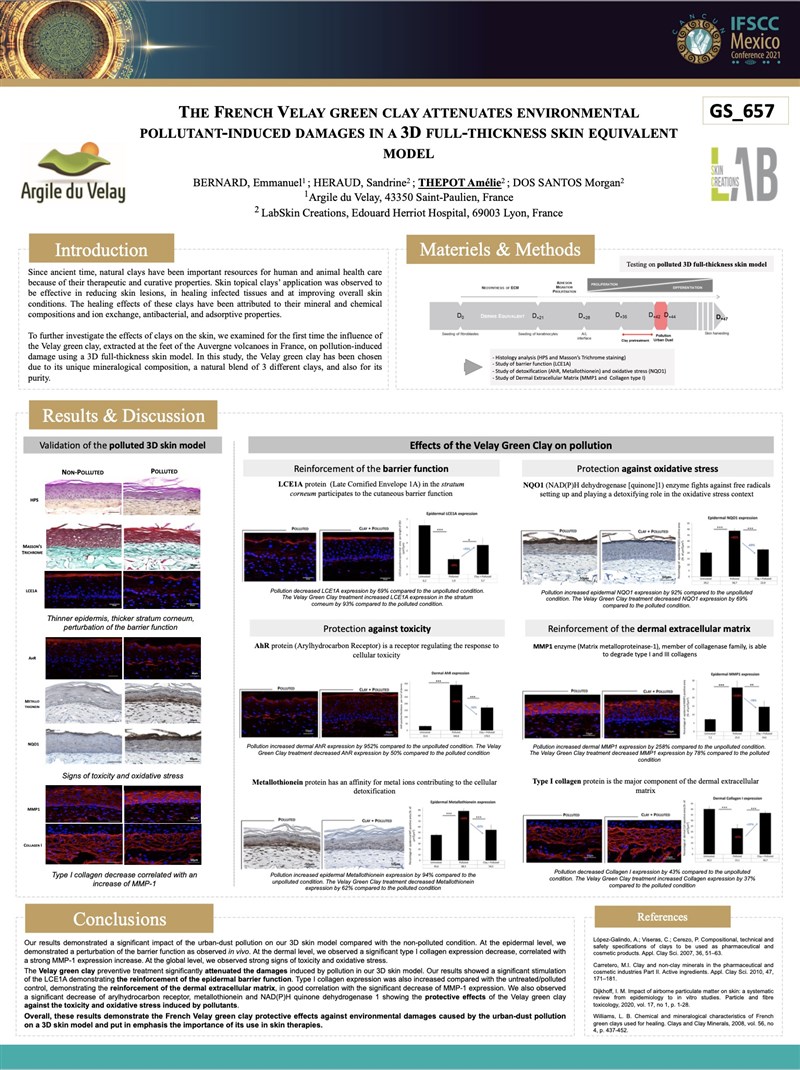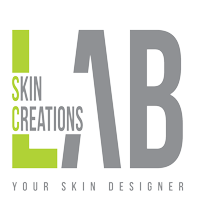LabSkin x Argile du Velay at the IFSCC 2021
3D Polluted Skin model
18/10/2021

Argile du Velay x LabSkin Creations at IFSCC Conference, 2021
👉 Discover how our innovative 3D skin models can sustain the development of high performant skin care products.
_________
French green clay originating from Velay attenuates environmental pollutant-induced damages in a 3D full-thickness skin equivalent model
Emmanuel BERNARD1, Sandrine HERAUD2, Amélie THEPOT2, Morgan DOS SANTOS2
1. Argile du Velay, Z.A. de Nolhac, 43350 Saint-Paulien, France ; 2. LabSkin Creations, Edouard Herriot Hospital, 5 place d’Arsonval, 69003 Lyon, France
INTRODUCTION
Since ancient time, natural clays have been important resources for human and animal health care because of their therapeutic and curative properties. Historically, clays have been used to treat dermatologic and toxicologic problems, mineral deficiency, and overall wellbeing in pharmaceutical, medical and cosmetic industries. Skin topical clays application was observed to be effective in reducing skin lesions, in healing infected tissues and at improving overall skin condition. The healing effects of these clays have been attributed to their mineral and chemical compositions and ion exchange, antibacterial, and adsorptive properties. To further investigate the effects of clays on skin, we examined for the first time the influence of the Velay green clay, extracted at the feet of the Auvergne volcanoes in France, on pollution-induced damage using a 3D full-thickness skin model. In this study, the Velay green clay has been chosen due to its unique mineralogical composition, a natural blend of 3 clays, and also to its purity, free of any quartz.
METHODOLOGY
To conduct such research, we perfected a 3D polluted skin equivalent model based on a unique collagen-glycosaminoglycans-chitosan porous polymer, in which dermal fibroblasts migrate, proliferate and neo-synthesize their own extracellular matrix. After 21 days of culture, epidermal keratinocytes were subsequently seeded on the top of the dermal equivalent. The Velay green clay was added daily in a systemic way to the 3D skin model. At the end of the culture, the urban-dust pollutant was added for 48 hours. After 42 days of total cell culture, polluted skin equivalent samples were systematically harvested to evaluate by histology and immunohistology the Velay green clay preventive effects on the epidermal barrier, the dermal repair, and on the detoxification system. Untreated and unpolluted conditions were used as controls.
RESULTS AND CONCLUSION
Firstly, our results demonstrated a significant impact of the urban-dust on both the epidermal and dermal compartments of our 3D full-thickness skin equivalent compared with the non-polluted condition. Histological analysis showed a thinner epidermis and a thicker stratum corneum, suggesting a perturbation of the barrier function as observed in vivo. At the dermal level, we observed a significant type I collagen expression decrease, correlated with a strong MMP-1 expression increase, also known as interstitial collagenase-1. Interestingly, Velay green clay preventive treatment significantly attenuated the damages induced by the urban-dust in our 3D skin model. Our results showed a significant stimulation of the LCE1A and type I collagen expression, compared with the untreated/polluted control, demonstrating the reinforcement of the epidermal barrier function and the dermal extracellular matrix, respectively. Strikingly, we also observed a significant decrease of arylhydrocarbon receptor, metallothionein and NAD(P)H quinone dehydrogenase 1 showing the protective effects of the Velay green clay against the oxidative stress induced by pollutants. Overall, these results demonstrate the French Velay green clay protective effects against environmental damages caused by the urban-dust on a 3D skin model and put in emphasise the importance of its use in skin therapies.






